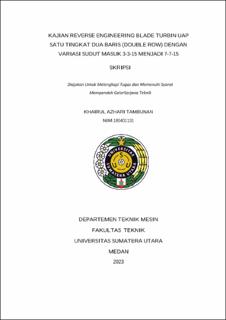| dc.description.abstract | Reverse Engineering is conducted with the aim of analyzing and comparing designs to determine which is superior. This comparison can be achieved through simulation or by creating a prototype. The blade is one of the key components in a steam turbine. Therefore, it is crucial to ensure that the blade component is in good condition for use. In this research, reverse engineering of steam turbine blades was performed, specifically changing the inlet angle variation from 3-3-15 to 7-7-15, and observing the results of both variations. The reason for reversing the inlet angle variation of the steam turbine blades from 3-3-15 to 7-7-15 in this study is the impact of the blade angle on the steam magnitude after the initial impact from the nozzle. As a result, a larger angle produces greater steam energy, thereby reducing losses. AutoCAD software was used to draw the 2D profile of the turbine blade, while SolidWorks and Ansys software were utilized to create the 3D model of the blade and conduct simulations. From the data obtained through simulations and theoretical analysis, it was found that the turbine blades with a 3-3-15 inlet angle variation experienced a more significant reduction in steam velocity. Specifically, the simulation results showed a decrease from 505 m/s to 132 m/s, and the theoretical data indicated a decrease from 432 m/s to 142 m/s. On the other hand, the turbine blades with a 7-7-15 inlet angle variation also experienced a reduction in steam velocity, with the simulation results showing a decrease from 611 m/s to 237 m/s, and the theoretical data indicating a decrease from 628.91 m/s to [missing value]. Based on the simulation and theoretical data, it was concluded that the turbine blades with a 7-7-15 inlet angle variation had the smallest percentage error. | en_US |


